


However; for the past 300 years we have consistently and repeatedly used just three or four of the most boring of these patterns, over and over again, in song after song.
Historically, Waltz tunes have tended to demand the basic rhythms only. That practice has given it the reputation of being the most boring beat-structure in music. It's really a shame too . . . since there are so many interesting permutations of Waltz that have never been used in a song. I blame song-writer ignorance. Most song writers aren't rhythmically aware of the vast potentials that do exist. With just a little more awareness they might be utilizing those potentials to dazzle the World with millions, billions and even quintillions of excitingly new and different, 3/4 song styles.
I will assume you have already studied the Basic Waltz lesson. If not, you should study it first.
This lesson expands on that one. In this lesson I want to take a minute to open some minds concerning the rhythmically mesmerizing Waltz beat potentials. There is absolutely no reason for all Waltz-beat songs to be as rhythmically boring as they have remained for the past 300 years.
First, it is important to realize that the beat can be categorized in a number of (note value) basic forms and the basic forms will literally explode with billions of variations, each. Two of the most interesting, (16th-note 3/4 and 8th-note 3/4) have rarely been used at all. When they have been used; those patterns usually remained in their most basic form. Each of those two forms contain a whopping 16-million possible variations.
Can you play each of the 5 basic (note value) forms of 3/4?
(HINT:If you are having trouble, you should follow this link to the Basic Waltz Beat lesson, mentioned above.)
Having said all that, our next step will be to get a jam going in at least one of the (note value) forms. Let's work on Eighth-note Waltz.
You will eventually want to gain expertise with simple variations then add snare and bass syncs later on. Eventually, you should begin dropping fills at random intervals. If you are not familiar with these two terms, 'variations' or 'Syncopations', you will need to back up and study those two online lessons. Variations and syncs work essentially the same way in ANY time signature, including this, the 8th-note 3/4 time-signature.
Get your variations and Syncopations happening with 'Eighth note Rock' first, then it will be easy to get them going in Eight-note Waltz.
I am surprised (even mystified) that this 8th-note form of Waltz isn't more commonly used than it is. It's the little (illegitimate?) red-headed and often ignored step-brother of our most popular song-beat pattern of all time: the 8th note Rock Beat. It secretly contains all the similar and familiar explosive rhythms of 8th 4/4 too.
The rhythmic potential is absolutely awesome. This beat structure is almost the same as 8th-note rock except there is one extra count in every repetition. That extra count makes a big difference in the over-all feel of the rhythms. Entire eras of innovative new music styles 'could' be based on what you are hopefully about to discover within this lesson. This beat-structure is primed and ready for just the right song composer-writer-drummer, to popularize.Let's look at some of the possibilities. We'll begin simple and graduate towards the more complex. First, notice how it resembles 8th rock. It's the same thing, but it contains one extra count in each measure. That's your first clue that it is potentially as rhythmically wild as the 8th Rock beat.
Basic 8th-Note Waltz:

The objective is to begin a jam with this rhythm structure. You may do anything you like with it so long as you don't lose track of the 3 count. It might be best to always play a bass on the count of 'one'. . . or downbeat. The downbeat is the first note in every measure. Repeat the basic rhythm several times then gradually begin to inject your own variations.
Here are just a few (simple) 8th-Note Waltz Variation Examples:
A.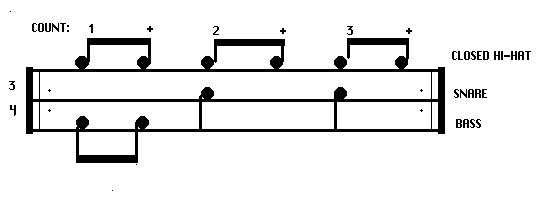
![]() Listen to it! Imagine lyrics and an intriguing melody.
Listen to it! Imagine lyrics and an intriguing melody.
Video: For almost all handheld devices and other browsers.
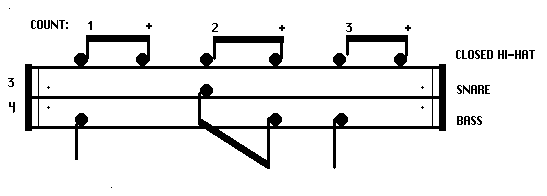
Video: For almost all handheld devices and other browsers.
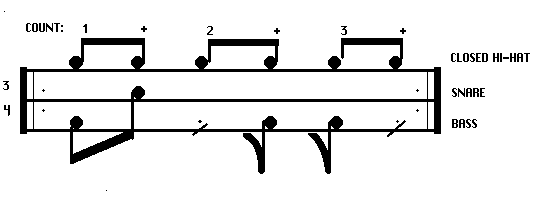
Video: For almost all handheld devices and other browsers.
Use your imagination! Create a few of your own patterns, then you can begin to think about adding syncs.
8th-Note Waltz Syncopation Examples: D.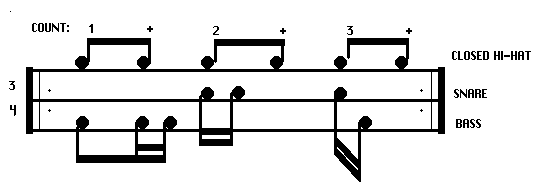
Video: For almost all handheld devices and other browsers.
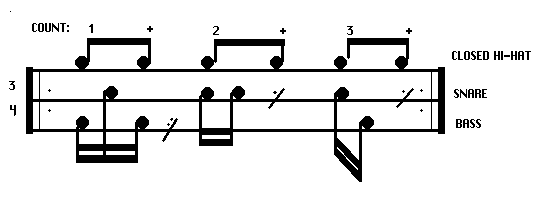
Video: For almost all handheld devices and other browsers.
![]() Hear all these Waltz beats played back to back.
Hear all these Waltz beats played back to back.
Again, use your imagination and create a few of your own ideas.
Adding fills to the Waltz beat is easy! Stick with 3-group-patterns (3-count rolls) in the beginning. Start your fill on the count of 'one' and play THREE groups of your chosen roll, then return to the hi-hat on 'one' of the next measure. Try all the Classic fills : 16th singles, doubles, paradiddles, 8th triplets, Roger's Ruffs , 8th notes, 16th triplets or any other roll that you may fancy.
Video: For almost all handheld devices and other browsers.
If you are having trouble with rolls and fills, see these two lessons:
1. Rudiments, Rolls & Fills (PART I)2. Rudiments, Rolls & Fills (PART II)
We have only focused on one (note-value) form of Waltz in this lesson, but common sense should dictate the rest. Strive to jam comfortably in each of the different (note value) forms of Waltz.
![]() Copyright Bill Powelson 1965-1995-2008-2014 @ all rights reserved.
Copyright Bill Powelson 1965-1995-2008-2014 @ all rights reserved.
![]()
![]()

![]()
Musical Time - Finite to Infinity:
Finite to Infinity:
Learn to easily jam and play music comfortably within any odd or even time signature. This material isn't currently taught in music-theory classes, yet it is simple enough for grade-school students. Discover more than 18 quintillion unique and different (modern music) song-beat structures.Discover the (lost) 500 year-old enigmatic secrets hidden within the current time-signature system. Seven short mesmerizing and easy-to-follow lessons will lead you quickly and easily towards (musical-time) guru status. You will learn to visualize (read, write or feel) the existence This should lead directly to the e-book.

This very informative little booklet will amaze you with hundreds of valuable tips and insider secrets! HOW TO: Purchase old/used drumsets for pennies and resell them for decent profits.